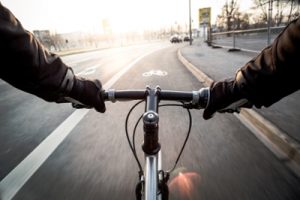With warmer summer weather rapidly approaching, it’s time to start watching out (or continue to) watch out for cyclists sharing the roads. Cycling is an extremely popular sport in our region, and cyclists take advantage of warmer weather to get out and enjoy the sport they love. Cyclists hit the roads for more than just leisure activities, too—many use their bicycles to commute to and from work.

In 2018, the Trauma Center at University of Utah Hospital treated 106 patients who suffered injuries related to bicycle incidents. Of those treated by trauma teams, more patients sustained orthopedic injuries, although more severe injuries like traumatic brain injuries (TBIs) and thoracic injuries did occur as well. The average age of these patients was 46 years old, and their average length of stay in University Hospital was 3.3 days, with one death in 2018 due to bicycling-related injuries. This data was pulled from our program’s trauma registry.
According to recent Utah Highway Safety Office data, several factors contribute to crashes between drivers and cyclists. Some of the top contributing factors for drivers included failure to yield to the right of way (42%), hit and run (6%), improper turn (4%), driver distraction (3%) and driver disregarding traffic signals and signs (2%). For cyclists, the top contributing factors included riding on the wrong side of the road (11%), improper crossing (9%) and disregarding traffic signals and signs (6%).
Both cyclists and motorists alike can take measures to keep our roadways safe. Everyone who uses America’s roads has a duty to drive safely so that drivers and cyclists can reach their destinations unharmed. In addition to common-sense safety habits like not using electronic devices while driving or riding and avoiding alcohol and drug use because they can impair judgment, the National Highway Traffic Safety Administration (NHTSA) offers tips to roadway users to prevent injuries to cyclists.
The NHTSA reminds drivers of their enormous responsibility to keep America’s roads safe. Getting to a doctor’s appointment, work, or school on time won’t matter if you strike a bicyclist while driving there. Always look for bicyclists whenever and wherever you are driving, and give them at least three feet of clearance when passing them on the road. In 2015, equal amounts of bicyclist fatalities occurred during the day and at night, but 61% of these fatalities took place at non-intersections.
While it is the responsibility of drivers to stay alert and aware of their surroundings, bicyclists can also take action to stay safe. Wearing a properly fitted bicycle helmet every time you ride is a must, as a helmet is a single-most effective way to prevent a head injury in a bicycle crash. Bicyclists should also remember to “dress for the occasion.” If you are out riding during the day, wear bright colors; at night, be sure to wear something with reflective materials along with placing front lights and red reflectors or flashing rear lights on your bicycle. In short, make yourself visible.
Unfortunately, in a crash between a vehicle and a bicyclist, if there is a fatality or an injury, it’s more likely that the bicyclist will get killed or hurt. Cyclists can take basic precautions like paying attention to their surroundings and not using electronic devices to ensure their safety. Distraction could lead to an unintentional swerve out of the bike lane or a missed stop signal. Bicyclists should not use headphones that distract from the task at hand and should keep their eyes and ears open for hazards like vehicles or trains.
Hopefully, you’re out enjoying the warmer weather and amazing recreation that Utah has to offer. But you get out on your bike, please wear a properly fitted bike helmet and follow the precautions outlined above. And if you get behind the wheel, keep an eye out for bicyclists.
